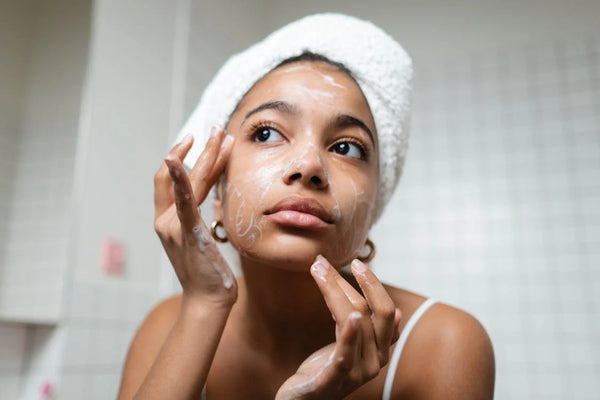
As we slog through the last of the cold, dry winter months, let’s take a moment to be thankful that soon we’ll all be able to say goodbye to the days of staticky hair, dry, itchy skin, windburned cheeks, and that enormous container of moisturizer we have to bring everywhere, so our skin doesn’t crack and itch while we’re outside.
In other words, unless you choose to spend the winter inside in your climate-controlled home with a humidifier running nonstop, winter is rough on the skin, and the upcoming springtime should offer a welcome reprieve from the classic cold weather problems.
With this happy transition comes the need to revamp your skincare routine! You had to abandon your lightweight moisturizer for something more substantial last fall when the days started getting shorter and colder. The products that keep you moisturized and comfortable in the bitter cold winds are not the right choices for spring and summer.
So, without further delay, let’s discuss five natural skincare transitions for spring that should keep you looking fresh and feeling great as life and color return to the world.
Thick, cream-based foundations and concealers tend to be greasy and clog pores when you begin to sweat again during the day. That’s why spring is the perfect time to store your winter products and switch to fresh, lightweight serums and makeup products!
We recommend switching to a mineral-based natural makeup for lightweight coverage that will reduce shine and keep your pores breathing freely. As for your moisturizing routine, try a soothing facial oil. Though it might seem counterintuitive to apply more oil to your face right as your skin starts producing more moisture on its own, the right facial oils will actually absorb quickly and moisturize deeply without making you look shiny.
Retinol is one of the most common ingredients in skincare products because of its ability to combat wrinkles and other signs of aging. However, retinol products may cause side effects that differ depending on your skin type.
You might fall into one of two camps:
Either you avoid retinol during the winter because it makes your skin dry and flaky, and you use more during the summer when your naturally moist skin can handle the harshness, or you avoid retinol use during the summer because it can cause you to sunburn more easily. An increase in UV damage can age your skin more quickly than if you hadn’t been using retinol at all.
Whether you have been using retinol or not, this is the time of year to adjust your strategy.
You could opt for more skin-friendly, natural alternatives, such as products that contain Vitamin C. Vitamin C is a natural anti-aging ingredient that is much gentler on your skin than the average retinol serum. It can also help heal sun damage in the event that a few stray UV rays sneak through your SPF defenses.
Depending on your skin type, your relationship to exfoliants can be dramatically different than someone else’s. Some people find that they have to exfoliate heavily all winter long to get rid of dry, flaky skin and the residue of heavy moisturizers and makeup. Others skip the exfoliants during the colder months because they feel that sloughing off too many skin cells will leave their thinner, more sensitive skin even more vulnerable to the harsh winter elements.
Regardless of your winter exfoliation routine, a gentle daily scrub will do you wonders as the weather warms up. Choose a natural exfoliant to gently remove dead skin cells, makeup, oils, sweat, and dirt from your daily routine while leaving the healthy skin underneath in great shape.
Natural exfoliants are preferable to harsh, chemical-based exfoliants, which tend to irritate sensitive skin and leave freshly uncovered cells more vulnerable to damage from UV rays, pollutants, and abrasive ingredients in other skincare products.
After a long winter cooped up indoors, the warm sunshine of spring and early summer can feel irresistible.
We applaud you for soaking in the glorious rays, but be sure to protect your exposed skin as you do it.
Most commercial sunscreens contain harmful chemicals that aren’t doing your endocrine system—or the world’s water supplies—any good. That’s why we recommend choosing natural sunblocks that contain zinc oxide or titanium dioxide. These are physical blockers that sit on top of your skin and deflect UV rays rather than being absorbed into your body (most commercial sunblocks are). Use lightweight sun protection with SPF in your foundation and lipstick for effortless UV defense.
If you want to skip bottled sunblocks altogether, you can opt for a wide-brimmed hat and a lightweight long-sleeved shirt to protect yourself in the great outdoors while still allowing for some beneficial vitamin D production to take place.
Even if your sun protection strategy is on point, it’s almost inevitable that some damaging UV radiation will sneak through and cause some free radical damage in your cells. Even if you were to stay under a large umbrella all summer long, you’d still accumulate some free radicals from pollution in the environment, from food, and even from some basic biological processes you can’t avoid.
The trick is to fight those free radicals with antioxidants that clear them from your body and prevent or even reverse the damage.
You can get some antioxidants from food—eat blueberries and dark chocolate to your heart’s content—but your skin will benefit greatly from antioxidants applied topically as well. Antioxidants you apply to your skin work on your surface cells, just as antioxidants you consume work to protect your internal cells.
Choose products containing Vitamin E, green tea, and natural (alcohol-free) witch hazel for great results. Apply generously to your face, neck, and hands, and don’t forget your ears, the tops of your feet, your lips, and any other areas that get exposed to the sun and your surrounding environment.
Once you’re all moisturized, protected, and made up to perfection, one of the best things you can do for natural skin health is to go out into the world and enjoy yourself! It will be several more months before you have to break out your winter hat and scarf again, so go soak up every minute of it. Live a happy, healthy life, and your skin will thank you for it!
Comments will be approved before showing up.



You will have hair challenges over the winter. Think back to years past. Fighting with frizz and static, dreaded hat hair, the feeling as if your locks are breaking off strand by strand every time you use a comb or brush, and so on.